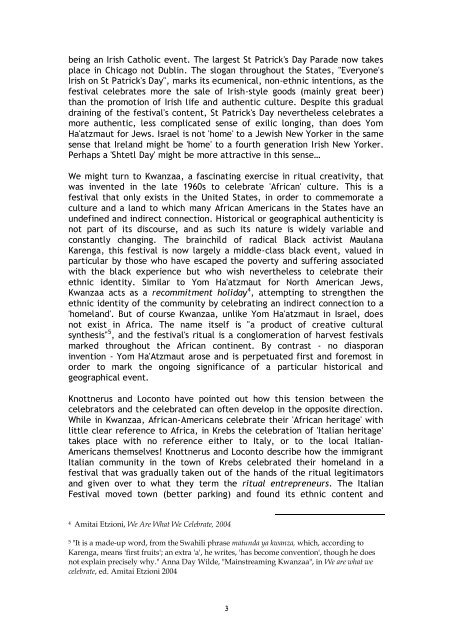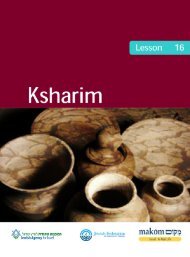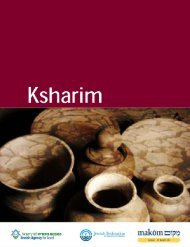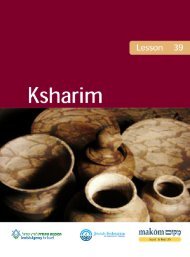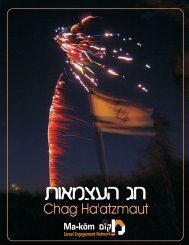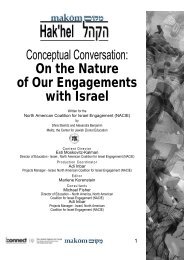printable pdf. - Makom Israel
printable pdf. - Makom Israel
printable pdf. - Makom Israel
Create successful ePaper yourself
Turn your PDF publications into a flip-book with our unique Google optimized e-Paper software.
eing an Irish Catholic event. The largest St Patrick's Day Parade now takesplace in Chicago not Dublin. The slogan throughout the States, "Everyone'sIrish on St Patrick's Day", marks its ecumenical, non-ethnic intentions, as thefestival celebrates more the sale of Irish-style goods (mainly great beer)than the promotion of Irish life and authentic culture. Despite this gradualdraining of the festival's content, St Patrick's Day nevertheless celebrates amore authentic, less complicated sense of exilic longing, than does YomHa'atzmaut for Jews. <strong>Israel</strong> is not 'home' to a Jewish New Yorker in the samesense that Ireland might be 'home' to a fourth generation Irish New Yorker.Perhaps a 'Shtetl Day' might be more attractive in this sense…We might turn to Kwanzaa, a fascinating exercise in ritual creativity, thatwas invented in the late 1960s to celebrate 'African' culture. This is afestival that only exists in the United States, in order to commemorate aculture and a land to which many African Americans in the States have anundefined and indirect connection. Historical or geographical authenticity isnot part of its discourse, and as such its nature is widely variable andconstantly changing. The brainchild of radical Black activist MaulanaKarenga, this festival is now largely a middle-class black event, valued inparticular by those who have escaped the poverty and suffering associatedwith the black experience but who wish nevertheless to celebrate theirethnic identity. Similar to Yom Ha'atzmaut for North American Jews,Kwanzaa acts as a recommitment holiday 4 , attempting to strengthen theethnic identity of the community by celebrating an indirect connection to a'homeland'. But of course Kwanzaa, unlike Yom Ha'atzmaut in <strong>Israel</strong>, doesnot exist in Africa. The name itself is "a product of creative culturalsynthesis" 5 , and the festival's ritual is a conglomeration of harvest festivalsmarked throughout the African continent. By contrast - no diasporaninvention - Yom Ha'Atzmaut arose and is perpetuated first and foremost inorder to mark the ongoing significance of a particular historical andgeographical event.Knottnerus and Loconto have pointed out how this tension between thecelebrators and the celebrated can often develop in the opposite direction.While in Kwanzaa, African-Americans celebrate their 'African heritage' withlittle clear reference to Africa, in Krebs the celebration of 'Italian heritage'takes place with no reference either to Italy, or to the local Italian-Americans themselves! Knottnerus and Loconto describe how the immigrantItalian community in the town of Krebs celebrated their homeland in afestival that was gradually taken out of the hands of the ritual legitimatorsand given over to what they term the ritual entrepreneurs. The ItalianFestival moved town (better parking) and found its ethnic content and4 Amitai Etzioni, We Are What We Celebrate, 20045 "It is a made-up word, from the Swahili phrase matunda ya kwanza, which, according toKarenga, means 'first fruits'; an extra 'a', he writes, 'has become convention', though he doesnot explain precisely why." Anna Day Wilde, "Mainstreaming Kwanzaa", in We are what wecelebrate, ed. Amitai Etzioni 20043


